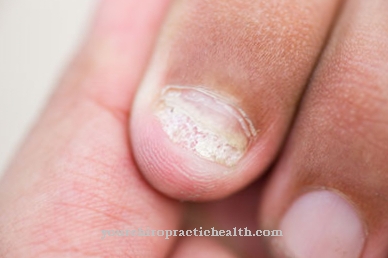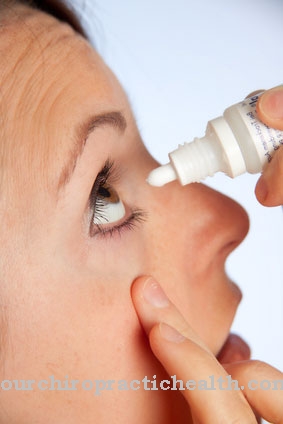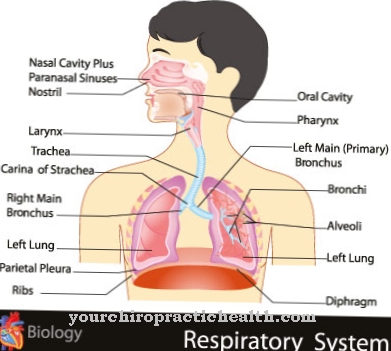The Reflux disease is noticeable through heartburn. Patients suffer from acid regurgitation, dry cough, hoarseness, and severe burning behind the sternum. This disease is widespread and must be treated to rule out consequential damage.
What is Reflux Disease?

Medical professionals speak of the Reflux diseasewhen the lining of the esophagus is inflamed. Stomach contents and acidic gastric juice flow into the esophagus because the sphincter of the stomach entrance fails and does not prevent reflux.
The lower third of the esophagus is inflamed from the irritation from the acid. If the reflux disease becomes chronic, there is a risk of secondary diseases such as esophageal cancer.
Reflux disease is a typical disease in industrialized countries. Here about 20 percent suffer from recurring heartburn. Children and infants can also suffer from reflux disease. The incidence is increasing, as is esophageal cancer. This is a rare consequence of reflux disease.
causes
The Reflux disease is triggered when the gastric entrance sphincter fails. Stomach contents and acid can flow back into the lower part of the esophagus. There are several factors that cause acid reflux disease.
These include a sphincter muscle that is too weak, too much passage through the esophagus through the diaphragm, and other anatomical deviations that prevent the upper gastric obstruction.
The risk of developing reflux disease is increased by nicotine, alcohol, obesity and certain medications. Some patients get heartburn when they are under stress.
Heartburn is particularly common during pregnancy. This is because the growing baby is pressing on the stomach. In the last trimester of pregnancy, a good half of women suffer from reflux disease.
Symptoms, ailments & signs
Heartburn, chest pain (retrosternal pain) and regurgitation, a reflux of contents from hollow organs, are typical of reflux disease. In this case, the reflux of chyme from the stomach into the mouth. In reflux disease, these symptoms are aggravated by eating, lying down, consuming alcohol, smoking, bending over, or physical and psychological stress.
Chest pain is located behind the breastbone (sternum) and is often confused with pain in the heart. It is a burning pain that is very uncomfortable and worsens after eating. Upper abdominal pain (epigastric pain), belching of air or gastric juice, and difficulty swallowing (dysphagia, odynophagia) are also common symptoms.
Reflux disease also shows up occasionally in atypical symptoms, such as the compulsion to clear one's throat, chronic cough, a feeling of lump in the throat (globus feeling), hoarseness, recurring pneumonia, bad breath (halitosis), a persistent feeling of dryness that cannot be relieved by drinking improved or penetrating, never-ending hiccups.
The acidic eructation and regurgitation result in secondary damage to the tooth enamel. Reflux disease can also occur in infancy. Here there are problems with the feeding of the infants and there is increased screaming and restlessness. In some cases, the infant will stretch their head back.
Diagnosis & course
The doctor can do that Reflux disease First diagnose based on the symptoms. This is done on the basis of the anamnesis interview, during which information about the type, frequency and lifestyle is important. Other diseases that have similar symptoms must be ruled out for the time being.
A gastroscopy is a safe diagnostic method. This is carried out especially in the case of chronic reflux disease in order to detect possibly malignant changes in the mucous membrane.With this esophagogastroscopy, not only changes in the mucous membrane can be recognized. Tissue samples can also be taken in the same step.
During the gastroscopy, a capsule can also be placed in the esophagus to measure the acidity over a period of 24 hours. Here doctors speak of long-term pH metry. The concentration of the acid is measured and the data is immediately transmitted to a recorder.
Complications
Reflux disease is at risk of complications as the disease progresses. These include esophagitis (inflammation of the esophagus). It is caused by constant contact with acid, which leads to changes in the mucous membrane. This can cause inflammation of the mucous membrane, which also swells. Basically, esophagitis is one of the typical sequelae of reflux disease.
The teeth can also be affected by the disease, which is due to the backflow of acidic stomach contents. Lesions of the tooth enamel become noticeable through pain-sensitive teeth, caries, periodontitis and inflammation of the oral cavity.
Another effect of reflux disease is narrowing of the esophagus. The cavity of the esophagus is narrowed by inflammatory strictures or reflux-related scars. This consequence becomes noticeable through disturbances of the swallowing reflex and pain.
Because the influence of gastric acid is permanent, there is a risk of chemical burns to the gastric mucosa. As a result, the formation of scars causes the esophagus to contract, which in turn causes a pronounced narrowing. Doctors then speak of a peptic stricture.
Another complication of reflux disease is the formation of ulcers in the lining of the esophagus. In most cases, they settle in the lower esophageal region, which is where the stomach meets. A possible consequence of the ulcer is bleeding, which can take an acute as well as a chronic course.
When should you go to the doctor?
Severe heartburn often occurs after eating fatty and spicy food. Affected people have an uncomfortable feeling in the mouth or a strong burning sensation. Heartburn is not a disease that must be treated by a doctor. If heartburn occurs several times a week for no apparent reason, such as pregnancy, you should speak to your doctor. The stomach contents flow back because fatty foods increase the pressure in the stomach. A doctor can determine the exact cause of the backflow of the food and prescribe appropriate medication.
Treatment & Therapy
By drug treatment of the Reflux disease the acid can be inhibited. Antacids, hydrotalcite and magaldrate neutralize or bind gastric acid. The products are available as tablets, gels, coated tablets and suspensions. They are usually taken when the symptoms arise. For example, at night or after a meal. Antacids are also suitable for pregnant women.
H2 antihistamines inhibit the formation of stomach acid. These H2-receptor blockers are usually taken at night and are available without a prescription. Proton pump inhibitors require a prescription. They are used for very severe complaints and block the formation of an enzyme that is responsible for acid formation. The symptoms disappear within two weeks. However, there is still a risk of cancer.
If the reflux disease leads to nausea and vomiting, prokinetics are also used. They stimulate stomach and intestinal movement and thus ensure a faster removal of stomach acid.
Chronic reflux disease can be treated surgically if drug treatment is unsuccessful. This operation is carried out as a minimally invasive procedure. The locking mechanism of the sphincter is restored. Stomach acid can then no longer flow back.
As home remedies for occasional complaints, rusks, yoghurt, milk and almonds have proven themselves.
You can find your medication here
➔ Medication for heartburn and bloatingprevention
Those who are prone to heartburn should avoid fatty and large meals. Especially in the evening, the stomach should not be burdened with too large portions. Diets high in fiber also help. Coffee, alcohol and nicotine promote reflux disease and should therefore only be enjoyed in very small amounts. Stress and excitement should be avoided. Anyone who is overweight should try to lose weight.
Aftercare
Various drugs affect the lower esophageal sphincter and thus promote gastroesophageal reflux. For this reason, the current medication should be critically checked and, if necessary, even replaced. Various measures can counteract potential reflux: These include avoiding large meals just before going to bed as well as raising the headboard while sleeping.
In general, enough sleep should be ensured. A severe lack of sleep can result in the esophageal mucous membrane becoming more sensitive to acidic gastric juice. There is no question that reflux disease can usually be treated well. In about 90 percent of cases, reflux esophagitis heals after PPI therapy.
However, when treatment is discontinued, relapses occur in around 50 percent of patients. If left untreated, complications can occur in some cases and these can be very serious. Anyone who temporarily takes medication against reflux and consciously changes their diet will most likely prevent permanent esophagitis.
You can do that yourself
People who are affected by reflux disease have a number of options to make everyday life easier with this disease.
Affected person should pay close attention to their diet. Acidic and heavy foods are to be avoided. Because the more spicy or acidic foods are consumed, the more acid is produced in the body. However, this process is counterproductive in reflux disease. If the person concerned wants to counteract the disease, they should focus on mild foods. Quickly digestible foods such as white bread, cooked vegetables or even rice are ideal for this disease. When it comes to beverages, patients should look for low-carbon beverages. The carbonic acid stimulates the acid production in the body. Still water or mild fruit juices are more suitable.
If help is needed with the composition of the diet, a trained nutritionist can be called in at any time. In addition to the nutritional basis, certain over-the-counter medications such as stomach gels or acid blockers can be taken. This method can also be discussed with the responsible doctor at any time. If these tips are followed, an improvement will be felt quickly and the symptoms will be alleviated.
























.jpg)



